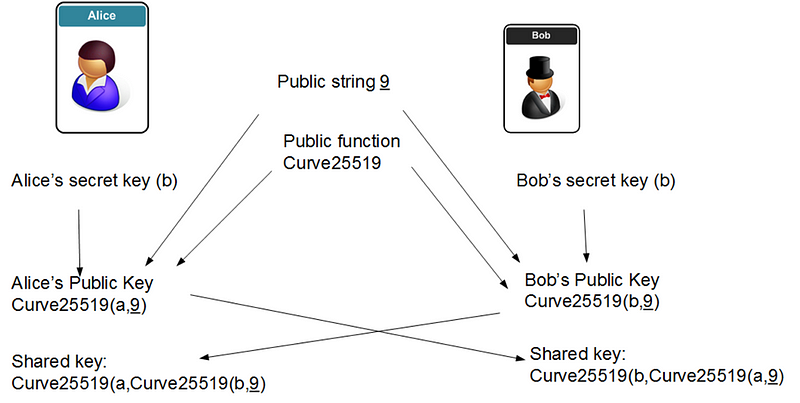If We Were To Create the Internet again … it would be Tor-based

If We Were To Create the Internet again … it would be Tor-based
Networking the proper way … Tor, Curve 25519 and ECDH
The Internet was NOT designed with integrated security, and where security was generally an after-thought. We needed to boot-up the Internet, and security was just not required when we created its infrastructure. And so virtually all our communications have since been flawed in some way, and where we use a sticking plaster of SSL. The proper way to do it — if we were to start again — is to encrypt the data at its source, and then use onion routing — Tor. At the core of Tor is ECDH (Elliptic Curve Diffie Hellman) and Curve 25519, and which gets its name from the prime number it uses for its calculations: 2²⁵⁵ — 19.
Tor routing
The Web traces a wide range of information, including user details from cookies, IP addresses, and even user behaviour (with user fingerprints). This information be used to target marketing to users, and also is a rich seem of information for the detection and investigation of crime. The Tor network has long been a target of defence and law enforcement agencies, as it protects user identity and their source location, and is typically known as the dark web, as it is not accessible to key search engines such as Google. Obviously Tor could be used to bind to a server, so that the server will only talk to a client which has been routed through the Tor network, which would mean than search engines will not be able to find the content on them. This is the closed model in creating a Web which cannot be accessed by users on the Internet, and only by those using Tor. If then users trade within the dark web servers with Bitcoins, there will be little traces of their transactions.
With the Tor network, the routing is done using computers of volunteers around the world to route the traffic around the Internet, and with ever hop the chances to tracing the original source becomes reduces. In fact, it is rather like a pass-the-parcel game, where game players randomly pass to others, but where eventually the destination receiver will eventually receive the parcel. As no-one has marked the parcel on its route, it’s almost impossible to find out the route that the parcel took.
The trace of users access Web servers is thus confused with non-traceable accesses. This has caused a range of defence agencies, including the NCA and GCHQ, to invest methods of compromising the infrastructure, especially to uncover the dark web. A strange feature in the history of Tor is that it was originally sponsored by the U.S. Naval Research Laboratory (which had been involved in onion routing), and its first version appeared in 2002, and was presented to the work by Roger Dingledine, Nick Mathewson, and Paul Syverson, who have since been named, in 2012, as one of Top 100 Global Thinkers. It since received funding from Electronic Frontier Foundation, and is now developed by The Tor Project, which is a non-profit making organisation.
The encryption involves each of the routing nodes having an encryption key, and the data is encrypted with each of the keys:

In this case the purple key is the encryption key of the first node, and is the last to be encrypted. As the data goes through the network, each node decrypts with their key. The last part of the communication, out of the gateway, will thus be non-encrypted, but a protocol such as HTTPS can be used to protect the last part of the communication.
Along the route, each Tor relay node takes the cell from its predecessor and decrypts with the negotiated symmetric key. It then passes the cell onto its successor. With Curve25519 we generate a 32-byte secret key (256 bits) and a 32-byte public key. A hash of the shared secret is then created as a 32-byte secret key (Curve25519(a,Curve25519(b,9)), as illustrated in Figure 7.22. This is used for a 128-bit or 256-bit AES key.

Curve 25519 and ECDH
We must thus create a unique encryption key for each routing host. This is achieved by using Curve 25519, and uses ECDH (Elliptic Curve Diffie Hellman). With this we select a base x co-ordinate point of 9 (G), and then Bob and Alice generate random values, and determine their public keys. Alice generates a, and Bob generates b. Alice’s public key will be:
9 times a (mod p)
and Bob’s public key becomes:
9 times b (mod p)
They exchange their values, and Alice multiplies by the value received from Bob by a, and Bob multiplies the value he receives from Alice by b. They should then end up with the same value:
K = 9 a b (mod p)
So here is a basic Go program to implement [here]:
A sample run is:
Alice Private key (a): fa10936fe8e7652a9504cf0970bf46dee8c94593ebd87f35a13dd4e1f4edd1ac
Alice Public key point (x co-ord): 901737441b60c4226be178a93839a192441cb3d0bf1321f9c95dd0831cebe93e
Bob Private key (b): 66f8df8f45f470c3a05826408de763f781c6aa5b61d0e5e040141acdd0e6e1e0
Bob Public key point (x co-ord): b05ea9404fea0c1c16640d96eec59c5412b8e07d4feac9d5a25dc458d0dae238
Shared key (Alice): 9a57c1bef48ae603466b34ba61c281ab93b0171e3e44a44e317427a46285ec71
Shared key (Bob): 9a57c1bef48ae603466b34ba61c281ab93b0171e3e44a44e317427a46285ec71
Conclusions
Tor is one of the most contentious areas of the Internet. For some it is a network of evil, and where bad people exist. For others it is a network of freedom. No matter which side you are on, if we were to rebuild the Internet from scratch, the Tor network is how we would build it. Curve 25519 is the basis of the key exchange method, and is fast and efficient.
And so, if we were to create the Internet again, would you probably adopt the Tor method of routing, as it is inherently secure (without relying on overlay tunnels).